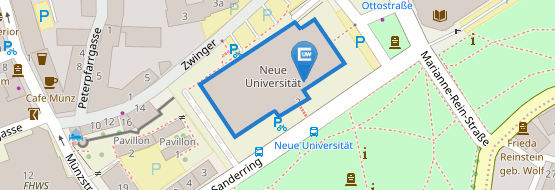Mental and Physical Health
The Julius Maximilians University (JMU) is committed to equal opportunities and diversity in its mission statement and inclusion agreement. Therefore, JMU has made it its goal to provide students and employees with disabilities or chronic illnesses with as barrier-free access as possible to study, research, and professional life. To achieve this, JMU offers the following counseling and support services:
Contact and Information Center for Students with Disabilities and Chronic Illnesses (KIS)
Since 2008, KIS has been centrally involved in improving the situation of students with disabilities and chronic illnesses. With a broad yet specialized range of services, KIS has taken on a pioneering role in the Bavarian university landscape and has since established itself as a model institution for inclusion in higher education. In addition to prospective students, current students, and doctoral candidates without employment contracts, the center also provides advice and support to the JMU faculty and staff of the central administration.
Representation for Severely Disabled Employees
The representation for severely disabled employees is responsible for all matters related to severely disabled and equally disabled employees at JMU and represents their interests towards the employer. Upon request, they can rely on the trusted persons for severely disabled employees or their deputies for support in everyday work and advice on labor law matters.
Healthy University
In collaboration with many different stakeholders, JMU has established a comprehensive health management system for all members of the university. The goal of the Healthy University initiative is to create a vibrant and diverse health culture by positively influencing the study and work conditions at JMU and continuously improving them. Through a wide range of health-promoting measures and offerings, JMU members are given the opportunity to enhance their personal health competence according to their individual possibilities, needs, and interests.
Gender, Gender Identity, and Sexual Orientation
Gender
The binary gender system—man and woman—is often assumed. Regardless of the gender system being referenced, gender is always socially constructed. From the concept of gender, we derive our gender roles and stereotypes.
The form of discrimination known as sexism, as well as sexual harassment, is often associated with the diversity dimension. Central to this is not the actual gender of a person, but the gender attributed to them by others, that is, how they are perceived and read by society.
Gender Identity
The term gender identity describes a person’s subjective feeling of belonging to the male, female, or a third gender, or of being somewhere in between. Gender identity may differ from a person’s biological sex and the gender role assigned to them by society.
Source: https://www.bmz.de/de/service/lexikon/geschlechtsidentitaet-57492
People whose gender identity does not, or does not fully, align with the sex assigned to them at birth often face discrimination. Transgender individuals are frequently subjected to transphobia.
Sexual Orientation
Sexual orientation describes the gender or genders to which a person is attracted. This attraction can be emotional, physical, and/or sexual.
Source: https://queer-lexikon.net/2017/06/08/sexuelle-orientierung/
Lesbian, gay, bisexual, transgender, and intersex people are often grouped together under the acronym LGBTQI. LGBTQI stands for Lesbian, Gay, Bisexual, Trans*, Inter*, and Queer individuals. The asterisk (*) represents additional identities.
When individuals are queer, in contrast to the prevailing heteronormativity, they may be subjected to queerphobia.
Hostility and discrimination based on gender, gender identity, or sexual orientation can be particularly burdensome for those affected, both within academic settings and in family environments.
Age
The diversity dimension of age refers to life circumstances related to a person’s age. Although age has not been explicitly included in the equality framework of Article 3 of the Grundgesetz (1949), it is enshrined as an impermissible discrimination characteristic in Article 21 of the Charter of Fundamental Rights of the European Union (2000) and is also one of the characteristics protected by the General Equal Treatment Act (AGG) (2006).
In addition to biological age, the context at Julius Maximilians University (JMU) also involves different life stages within the university environment. Freshmen are in a different phase compared to post-docs, and newly hired graduates often work with colleagues who are 20 years older.
JMU aims to protect and support all of its members, regardless of the life stage they are in. A particular focus is placed on age groups that are affected by structural exclusion and disadvantage. Specific to older individuals, participation in study, research, and professional life in a university setting is often associated with barriers based on practical or historical reasons. For example, in Bavaria, there are certain age limits for participation in central allocation procedures for restricted-admission degree programs or for the appointment of university employees to civil servant positions. However, due to societal developments such as demographic change , these exclusion mechanisms need to be constantly renegotiated. This also applies to more subtle forms of age-related devaluation, which can be expressed in common attitudes, such as the preconception that young students are “unreliable” or older colleagues are “conservative.”
JMU strives to reduce age-based disadvantages for its members and to create age- and age-appropriate structures wherever possible. This includes, for example, the establishment of an anti-discrimination office (starting 2024) and the counseling and support services offered by the family service. As the proportion of students with study-related impairments and the propoertion of severely disabled employees continues to grow with age, university-specific offerings, such as those provided by the KIS and the Gesunden Hochschule are increasingly equipped to address age-related challenges. In addition to a deficit-oriented compensation approach, JMU also invests in the competence-oriented use and promotion of the benefits that a broad age range within its student body and workforce brings. Learning opportunities in the form of early study programs or senior citizen studies, for example, not only serve personal intellectual development but also expand the spectrum of our knowledge society, which cannot afford to overlook any perspective.
Science International and Intercultural
To strengthen JMU as an internationally networked university, the welcoming culture at all career levels should be further expanded, which will also enhance the university's international reputation as a study and work environment. One of the main goals is to fundamentally revise the internationalization strategy, which includes the creation of a core dataset for internationalization. The completion of the strategy is planned for the end of 2023; the results from the participatory workshops during the audit process will be incorporated into the internationalization strategy concept.



